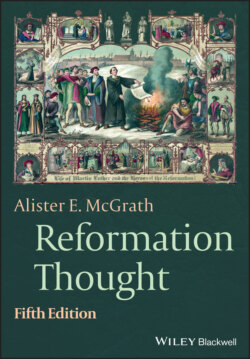Читать книгу Reformation Thought - Alister E. McGrath - Страница 33
Doctrinal Confusion: A Crisis of Authority Within the Church
ОглавлениеOne of the most significant features of medieval religious thought is the growth of “schools” of theology in universities and monasteries. Each of these schools of thought took significantly different positions on a number of major theological questions, including the doctrine of justification (to which we shall return in Chapter 7) – such as what the individual had to do in order to be justified.
So which of these schools of thought was right? Which corresponded most closely to the official teaching of the church? In the late fifteenth century, there was widespread confusion over what was merely “theological opinion” and what was “Catholic dogma.” Nobody could be quite sure exactly what the official teaching of the church was on certain matters – including its teachings on what people needed to do in order to be sure of their salvation.
An episode from the late Italian Renaissance illustrates this point particularly well. During the first decade of the sixteenth century, a small group of young Italian noblemen met regularly, in order to discuss matters of religion. The members of this group shared a common concern: how to ensure the salvation of their souls. But how could this be done? What did they have to do in order to be saved? There appeared to be no obvious answer.
A crisis developed within the group, culminating in 1510. The group split into two sections. One group, convinced that salvation could come about only by a rejection of the world and personal denial, withdrew to a local monastery, there to work out their salvation safe from the influences of a fallen world. The second group chose to remain in the world. Somehow, they reasoned, it must be possible to remain in the world and attain salvation. But nobody was entirely sure of the official position of the church on this major question – an issue which Luther addressed head-on in his doctrine of justification by faith.
Confusion over the official teaching of the church on justification contributed in no small manner to the origins of Luther’s program of reform in Germany. The most recent known authoritative pronouncement on the part of a recognized ecclesiastical body relating to this doctrine dated from 418, and its confused and outdated statements did little to clarify the position of the church on the matter in 1518, eleven hundred years later. It seemed to Luther that the church of his day had lapsed into Pelagianism (see pp. 82–3), an unacceptable understanding of how an individual entered into fellowship with God. The church, Luther believed, taught that individuals could gain favor and acceptance in the sight of God on account of their personal achievements and status, thus negating the whole idea of grace.
Luther may well have been mistaken in this apprehension – but there was so much confusion within the church of his day that no one was able to enlighten him on the authoritative position of the church on the matter. We can speak of a spectrum of thought within the late Middle Ages. A remarkably wide range of doctrines was in circulation, and it was not always clear which were “official doctrine” of the church.
It is all too easy for twentieth-century writers, with the benefit of hindsight, to recognize the potential dangers for the religious establishment of the ideas being developed by the first reformers – but at the time these ideas attracted little attention from the official defenders of orthodoxy. The boundary lines between what was orthodox and what was not became so hopelessly confused that it was virtually impossible to treat individuals such as Luther as heretical – and by the time this move became necessary, the Reformation had gained such momentum that it proved difficult to obstruct it. The scene for a future religious confrontation was set by the doctrinal pluralism of the late medieval church.
It is interesting to note that early Catholic criticisms of Luther failed to pick up on the importance of his doctrine of justification by faith alone. Most critics of Luther in the early 1520s portrayed him as repeating the discredited ideas of John Wycliffe and Jan Hus that were subsequently condemned by the Council of Constance. Very few realized that Luther was actually articulating a coherent theological vision, with the potential to rival that of any of the great Catholic theological systems.
The English Catholic theologian John Fisher, bishop of Rochester, realized the significance of Luther. In May 1521, Fisher identified three central themes which he believed lay at the core of Luther’s theology: the denial of papal primacy, the affirmation of justification by faith alone, and the restriction of doctrinal authority to Scripture alone. Fisher rightly suggested that these core theological themes of justification by faith and the sole authority of the Bible lay at the heart of Luther’s reforming program, and that everything else was erected on this foundation.
